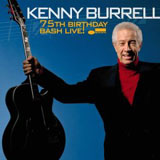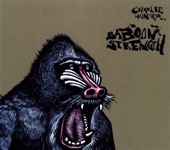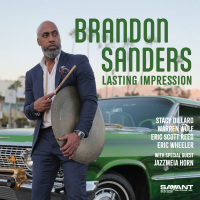Home » Jazz Articles » Profile » Kenny Burrell: Mr. Good Notes
Kenny Burrell: Mr. Good Notes
...what I'm striving for really is very close to the sound of the acoustic guitar, only louder. That's basically because I love that sound.
 "I'm just trying to play the good notes," says Kenny Burrell, lighthearted laughter accompanying his response to the question of how he would characterize his style of guitar playing. The reply betrayed the genial humility that has long distinguished him as one of the music's truly gracious gentlemen. Burrell has been playing the "good notes" for well over half-a-century now, his lengthy resume and voluminous discography—arguably the greatest of any jazz guitarist—a testament to an unrivaled versatility, an important component of his simple, understated, but nevertheless clearly apparent instrumental virtuosity, virtuosity that is deeply rooted in his ability to produce some of the fullest, warmest, most beautiful tones to ever emanate from an electric instrument: he inspired Jimi Hendrix once to remark "Kenny Burrell, that's the sound I'm looking for."
"I'm just trying to play the good notes," says Kenny Burrell, lighthearted laughter accompanying his response to the question of how he would characterize his style of guitar playing. The reply betrayed the genial humility that has long distinguished him as one of the music's truly gracious gentlemen. Burrell has been playing the "good notes" for well over half-a-century now, his lengthy resume and voluminous discography—arguably the greatest of any jazz guitarist—a testament to an unrivaled versatility, an important component of his simple, understated, but nevertheless clearly apparent instrumental virtuosity, virtuosity that is deeply rooted in his ability to produce some of the fullest, warmest, most beautiful tones to ever emanate from an electric instrument: he inspired Jimi Hendrix once to remark "Kenny Burrell, that's the sound I'm looking for."Guitarist Russell Malone, who counts Burrell as a primary influence, is another impressed by his tone. "One of the things that I've always liked about (Burrell) is his sound—it's so nice and round and full. It's just the sound: it's pure, it's not cloudy or muddy, it's just real pure. It's almost like a voice and even though he's playing an electric guitar, you can still hear the natural acoustic qualities of the instrument." Burrell confesses, "People have asked me many times 'How do I get the sound' and I say, 'Well I'm not quite sure,' but what I'm striving for really is very close to the sound of the acoustic guitar, only louder. That's basically because I love that sound, so when I play the electric guitar I want to have that warmth and midrange that is very close to the sound of the acoustic guitar."
Burrell has been heard regularly throughout his career on both electric and acoustic guitars, one of the few jazzmen of his generation to embrace the latter instrument. While his reputation was forged as one of the first bop guitarists—he made his recording debut with bebop pioneer Dizzy Gillespie and recorded regularly for the two premiere hard bop labels Blue Note and Prestige early in his career—Burrell's sound also made him a favorite of the music's finest orchestral arrangers, including Gerald Wilson, Quincy Jones, Oliver Nelson, Creed Taylor and Gil Evans: his album Guitar Forms (Verve, 1964) arranged by Evans, is universally hailed as a masterpiece. The guitarist says, "One of things that I tried to do in doing those records was to bring out the importance of the guitar itself, the acoustic sound of the guitar. I mean certainly everybody is very well aware of the electric guitar in jazz, but there is a role for the acoustic guitar as well and that's one of the things that I love. I love that sound and I try to make sure that that is done right."
Burrell came to New York this month to perform at Dizzy's Club, his first appearance in the city in nearly a decade. "I'm feeling great about coming back to New York and looking forward to it," he said. He was joined by his California drummer Clayton Cameron and Jazz Messenger alumni pianist Benny Green and bassist Peter Washington, along with a young discovery of his, 22-year-old saxophonist Tivon Pennicott. "I think people will like him," the NEA Jazz Master predicted. "I know we'll have a great musical time and I hope that people will come out and share it with us."
Burrell's love of the guitar and music in general began at home in Detroit, where he was born on July 31st, 1931. His mother sang in the church choir and played piano. His father favored string instruments like the banjo and ukulele. Burrell picked up the guitar at the age of 12 and credits his older brother Billy, who started out on the instrument and then switched to electric bass so that they could play in a band together, as a major influence on his musical philosophy. "He always told and encouraged me to follow the ideas that I came up with, the ideas that I truly thought were worthwhile, to go ahead and follow them."
The younger Burrell went on to earn a BA in music composition and theory at Wayne State University, while also privately studying classical guitar. More importantly he became an integral part of his hometown's burgeoning bebop movement, playing at local clubs like the Bluebird with the likes of Tommy Flanagan, Yusef Lateef, Pepper Adams and Elvin Jones, as well as with visiting luminaries. "I actually played with Charlie Parker at one time [and] Miles Davis ... just while I was in Detroit," he recalls proudly.
"They would come through and they would have local bands play with them and they would often— times pick me to be in the local band to back them up. Charlie Parker was very encouraging when he heard me. He said, 'Yeah man, you sound good.' To a youngster in his teens, when somebody like Bird says that, it's very encouraging. And then Dizzy Gillespie when I was 19 asked me to go on the road with him ... You realize, well you must be doing something right."
A national tour with Oscar Peterson convinced Burrell that he was ready to make the big move to New York. He remembers the day in 1956 when, while hanging out with Tommy Flanagan, "I decided I was going to go and I said, 'You want to go' and he said 'Yeah.' So we just got in my car and we came. We came together." The city welcomed the young Detroiters with open arms, particularly Burrell who recorded a plethora of albums, both as a leader and sideman, during his first year there—dates with Flanagan, Kenny Dorham, Donald Byrd, Paul Chambers, John Coltrane and many others, including Jimmy Smith, with whom he made dozens of recordings through the years that were among the era's most popular. For more than a decade and a half the guitarist was one of the most in- demand artists in the city's many clubs and recording studios and even on Broadway (he appeared in the pit bands for shows "Bye-Bye Birdie" and "How To Succeed In Business"). Then, in 1971, he picked up and moved to the West Coast.
Los Angeles in the '70s was just as welcoming to Burrell as New York had been in the '50s. He performed there frequently with his own group when not touring and recorded regularly for California record labels Fantasy and Concord. Just as importantly, he began teaching at UCLA, beginning with a course on the music of Duke Ellington. "I understand that that was the first regular course on Ellington in the country, started in '78 with me. I had a hunch that that would be a good thing to do and I think my hunch was right." Burrell has remained at UCLA for the past 30 years, teaching part—time at first and then being named to the full—time position of Director of the Jazz Studies program he began in 1996. Through the years with the faculty he has enlisted in the program well-known jazz instrumentalists including George Bohanon, Billy Childs, Billy Higgins, Harold Land and Gerald Wilson.
"Our mission is to prepare these young people to go out and compete in the jazz world, in the music world," the Director says, "and also to find their own musical voice, so that they can express the uniqueness that is in them. I think that one of the ways that we have done that is because of the faculty, that we got together here. These are all experienced musicians who are still active in the field and understand music business. But the main thing is that we recognize when we hear some unique phrases, some original ideas and we encourage that because we know the history of the music, so when we hear someone come up with some new ideas or some unique phrases we point it out to them and let them know that we feel that they have something special to offer and (that they should) work on that.
So the bottom line on that is to develop your own unique self. And lastly, try to make a contribution to the jazz world, so the music can continue and grow."
 Burrell has continued to grow throughout his 50—plus year recording career, his "good notes" getting better and better and his warm mellow tone aging like fine wine. In 2007 Blue Note Records, the label for which he recorded his first date as a leader (the classic Introducing Kenny Burrell (Blue Note, 1956) over a half a century before), documented the current state of the guitarist's art with 75th Birthday Bash Live! (Blue Note, 2006). The date was culled from a week at Yoshi's [Oakland, California], during which guests Hubert Laws and Joey DeFrancesco joined the leader, followed by one very special night at the Kuumbwa Jazz Center, where Burrell was celebrated as featured soloist with the Gerald Wilson Orchestra. This year he celebrated his 77th birthday appearing as a special guest (alongside Bobby Hutcherson and Joe Lovano) in a concert at UCLA's Royce Hall commemorating the 90th birthdays of both Gerald Wilson and Hank Jones (who like the guitarist was born on July 31st).
Burrell has continued to grow throughout his 50—plus year recording career, his "good notes" getting better and better and his warm mellow tone aging like fine wine. In 2007 Blue Note Records, the label for which he recorded his first date as a leader (the classic Introducing Kenny Burrell (Blue Note, 1956) over a half a century before), documented the current state of the guitarist's art with 75th Birthday Bash Live! (Blue Note, 2006). The date was culled from a week at Yoshi's [Oakland, California], during which guests Hubert Laws and Joey DeFrancesco joined the leader, followed by one very special night at the Kuumbwa Jazz Center, where Burrell was celebrated as featured soloist with the Gerald Wilson Orchestra. This year he celebrated his 77th birthday appearing as a special guest (alongside Bobby Hutcherson and Joe Lovano) in a concert at UCLA's Royce Hall commemorating the 90th birthdays of both Gerald Wilson and Hank Jones (who like the guitarist was born on July 31st). "Well, that was very special," he enthuses. "You know it's one thing to live that long, but to be that productive and creative is just wonderful ... I guess there's some magic in this music. I don't know what it is, but it certainly works and I'm glad ... it's inspired me to keep going and do better things."
Selected Discography
Kenny Burrell, Introducing: The First Blue Note Sessions (Blue Note, 1956)
Jimmy Smith, Midnight Special (Blue Note, 1960)
Kenny Burrell, Midnight Blue (Blue Note, 1963)
Kenny Burrell, Guitar Forms (Verve, 1964)
Kenny Burrell, God Bless the Child (CTI-Epic/Legacy, 1971)
Frank Morgan, Listen to the Dawn (Verve Antilles, 1993)
Kenny Burrell, 75th Birthday Bash Live! (Blue Note, 2006)
Photo Credit
Bob Barry
Tags
Kenny Burrell
Profiles
Russ Musto
United States
New York
New York City
Russell Malone
Gerald Wilson
Quincy Jones
Oliver Nelson
Creed Taylor
Gil Evans
Benny Green
Peter Washington
Tommy Flanagan
Yusef Lateef
Pepper Adams
Elvin Jones
Charlie Parker
oscar peterson
Kenny Dorham
Donald Byrd
Paul Chambers
John Coltrane
duke ellington
George Bohanon
Billy Childs
Billy Higgins
Harold Land
Hubert Laws
Joey DeFrancesco
Bobby Hutcherson
joe lovano
PREVIOUS / NEXT
Support All About Jazz
 All About Jazz has been a pillar of jazz since 1995, championing it as an art form and, more importantly, supporting the musicians who make it. Our enduring commitment has made "AAJ" one of the most culturally important websites of its kind, read by hundreds of thousands of fans, musicians and industry figures every month.
All About Jazz has been a pillar of jazz since 1995, championing it as an art form and, more importantly, supporting the musicians who make it. Our enduring commitment has made "AAJ" one of the most culturally important websites of its kind, read by hundreds of thousands of fans, musicians and industry figures every month.


























